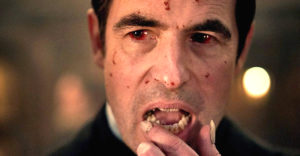I hadn’t given the dangers of being buried alive much thought before my visit to an Edgar Allan Poe museum in Richmond, Virginia. I knew what every schoolchild knows — that some Victorians were so terrified at the prospect of waking up in their coffins they had alarm bells installed within. The only modern reference I could recall was the scene in Kill Bill 2 in which Uma Thurman is interred alive and escapes with a one-inch punch. In other words, I was in a state of happy ignorance.
I write an Edgar Allan Poe museum because there are three such institutions in the United States — four, if you count the small cottage in the Bronx where he spent the last years of his life. The Richmond museum boasts the largest collection of Poephemera in the country. There are manuscripts covered with his looping, butterfly script. Letters and a silk waistcoat. You can admire Poe’s soup ladle, gawp at his walking stick and boat hooks, even cast an eye over his socks. I bought his collected stories in the museum shop and flicked through them that evening, finally choosing one that was new to me. The Premature Burial (1844) is about a man who escapes pathological fear and returns to the state of humdrum discontent commonly known as sanity. I read it with interest, hoping to pick up some tips.
The man’s fear is particular. He is taphophobic — morbidly afraid of being buried alive. This is reasonable enough, as he’s given to cataleptic episodes that render him cold and lazy-pulsed for extended periods. He is haunted by the prospect that one of these fits will overcome him while he is away from those aware of his condition. It would only be a matter of time before some officious bystander had him boxed-up and buried. Then would come the macabre revival: “The unendurable oppression of the lungs — the stifling fumes of the damp earth — the clinging of the death garments — the rigid embrace of the narrow house…”
Our narrator prepares for the worst. He commissions the cosiest possible coffin, complete with a bell that can be pulled from within. He stipulates that the lid must not be screwed down and that a supply of food and drink should be left within the family crypt in case he wakes up peckish. And then one day he opens his eyes onto darkness and confinement and finds that he is not in his cosy coffin, that there is no bell-pull, that there is no way out. I won’t reveal the story’s conclusion here. But I was struck by the power of the tale, and by the realisation that it did not employ gibbering fiends or lonely castles. No, it derived its strength from the very real fears of the age.
Forty years after The Premature Burial was published, a Welsh clergyman found that he had a corpse problem: one particular corpse was not doing what it was supposed to do. It was, quite literally, acting up.
Eleven years before, a 73-year-old woman had died in the village of Llanelly. The cause was recorded as “unknown” in the register of deaths. She was laid out for three days before burial in a brick tomb that had been designed to accommodate two coffins. Hers was the first. In 1884, the tomb was opened to allow the interment of a relative, only for the gravedigger to uncover a disturbing scene.
The coffin’s lid had been “forced upwards”, creating a gap of about eight inches between casket and lid. The corpse’s right arm and right leg protruded through the gap so that they hung over the edge of the coffin, with the right knee pressed against the tomb’s interior wall. It was as if the dead woman had attempted to climb out of her own resting place.
There seemed only one conceivable explanation — a terrible mistake had been made 11 years before. And so, in May 1884, the Revd. David Williams wrote to Britain’s foremost medical journal, The Lancet: “Will any of your readers give me the benefit of their opinion as to whether the following was a case of being buried alive?”
The Vicar of Llanelly did not have to wait long for an answer. On 7 June, The Lancet published two responses to his query. Somewhat unhelpfully, they took entirely opposing views on the matter. Charles Williams, District Medical Officer of the Bodmin Union, thought the question ridiculous and said that the events at Llanelly were due to an explosive build-up of the “gases generated during putrefaction”. Dr William O’Neill of Lincoln was less optimistic. He was so convinced that live burial was a real danger that he argued interment should not take place until a doctor had formally certified evidence of decomposition in the cadaver.
Not all the responses were of a scientific character. One in particular had more in common with Poe’s fiction than medical debate. On 14 June, The Lancet published the reminiscences of a traveller who claimed to have seen evidence of live burial in the cathedral crypt at Bordeaux. There some recently uncovered corpses in remarkable states of preservation were displayed on iron frames. He was shown two bodies that left him in no doubt as to the risks of over-hasty inhumation:
“I am unable to attribute the position in which they were found in their coffins, and the look of horror which their faces still displayed, to any action of rigor mortis or any other post-mortem change, but simply and solely to their having awakened to a full appreciation of their most awful position… In the year 1870 these two bodies were still on view; and the attendants used to dwell at some length upon the horrors of being interred alive.”
In the end, the Revd Williams accepted the explosive gas theory, no doubt grateful that he would be able to calm his worried flock with a reassuringly scientific explanation. The fact that one letter provoked such a range of responses is telling. Dr Williams’s rational appraisal. Dr O’Neill’s cautious pessimism. The ghoulish rubbernecking of the tourist. It was a subject that intrigued and appalled, that fed Victorian passions for both science and the macabre.
Yet fear is a slave to fashion. As the physician Jan Bondeson has shown in his gripping book on the subject, concern about live burial among the general population seems to have declined rapidly after the First World War. The age of mechanised warfare had given people quite enough to worry about above ground.
You might think that live burial is now the sole preserve of horror fiction and Tarantino films; that the anxieties of the Revd Williams are nothing but a macabre footnote. After all, we are no longer reliant on the judgments of port-sodden sawbones. We have the full beeping arsenal of modern medicine to track our journey into the dark. What could go wrong?
Rather a lot, it seems. Examples of near misses in our own age are not difficult to find. A woman who woke up in a Polish morgue in 2009. An Australian man who tried to escape his body bag in 2022. A woman in Ecuador who started banging on the coffin during her own wake last June. Two weeks ago, on Friday 13 October, paramedics in County Durham declared a man deceased, only for staff at Darlington Memorial Hospital to discover that he was still alive.
Such incidents are rare enough to be newsworthy. But they do make you wonder. Bondeson ends his book with a chapter entitled “Are people still being buried alive?” The answer is: perhaps, in an extremely limited set of circumstances. Apparently, the main situation every taphophobe should avoid is a surfeit of drugs or alcohol in sub-zero temperatures — extreme intoxication and hypothermia form the combination most likely to fox an exhausted medic.
Bondeson relates his own experience of treating a woman who had enjoyed several bottles of vodka while sitting on her freezing balcony. The police who brought her to hospital assumed that she had passed away. In fact her heart was still beating, though so slowly as to be almost imperceptible. Bondeson managed to revive the patient, noting that “her marked obesity, isolating the inner organs from the cold, was probably to be thanked for the fortunate outcome of this case”.
Bondeson’s anecdote fascinates because it underlines the role of chance. All tales of live burial do, whether they take the form of creepy fiction or learned debates in The Lancet. When Pliny the Elder wrote of men who had awoken on their own funeral pyres, he bemoaned fortune’s vicissitudes, “so much so, that we cannot be sure of any thing, no, not even that a person is dead”. The fear is greater than the horror of premature burial. It lies in the knowledge that such tragedies might have been averted had the funeral been delayed by a day, an hour. This is the dreadful if only that torments Poe’s taphophobe. He imagines the cruelty of the “memory of dear friends who would fly to save us if but informed of our fate, and with consciousness that of this fate they can never be informed…”
Live burial remains the most awful fate imaginable. Not because it is especially likely. Not even because of the grisly details. But because it disrupts our fond dreaming of an ordered world, in which death and life are cleanly separated by six feet of earth.
Disclaimer
Some of the posts we share are controversial and we do not necessarily agree with them in the whole extend. Sometimes we agree with the content or part of it but we do not agree with the narration or language. Nevertheless we find them somehow interesting, valuable and/or informative or we share them, because we strongly believe in freedom of speech, free press and journalism. We strongly encourage you to have a critical approach to all the content, do your own research and analysis to build your own opinion.
We would be glad to have your feedback.
Source: UnHerd Read the original article here: https://unherd.com/




